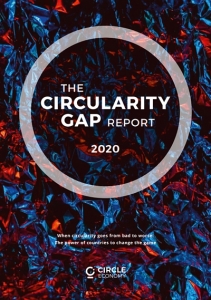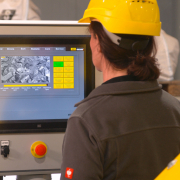The Potential of Recycling
According to Circle Economy, an impact organization dedicated to accelerating the transition to a closed loop, the world is only 8.6 percent circular. This is the finding of the “Circularity Gap Report 2020”, which was presented at the World Economic Forum in January in Davos. Of all the minerals, fossil fuels, metals and biomass that are worldwide used each year, only 8.6 percent are cycled back, the organization informed. This had fallen from 9.1 percent in the two years since the first report was launched in 2018.
The report, published as part of the Platform for Accelerating the Circular Economy (PACE), found out that the global economy is consuming 100 billion tons of materials a year “for the first time ever“, but the cycling rate of resources had gone into reverse. The reasons for this trend are high rates of extraction, ongoing stock build-up and low levels of end-of-use processing and cycling.
As the authors state, countries are the critical facilitators of the circular economy. “Some countries operate well within the ecological boundaries of our planet, but without satisfying basic social needs. Other countries do fulfill societal needs but do so by overshooting the sustainable means of the planet. Therefore, all countries are developing,” they are convinced. “All countries are unique when it comes to their ecological footprint and ability to provide for their people. Some face similar barriers, and many are confronted with the same global trends. This year’s Circularity Gap Report examines and extrapolates common challenges and opportunities experienced by distinct country groups and provides action pathways for each.”
In this report, the countries of the world are differentiated into “Build”, “Grow” and “Shift” countries.
“Build” countries
According to the definition, these states have a low material footprint per capita. “As a result, the impact of their economic activities often falls within the regenerative capacity of the planet,” the authors inform. “Natural capital, rather than human capital, is their dominant source of wealth, which means that the focus is on extraction and sale of raw materials, while investment in education and skills is insufficient.”
The good news is their potential, the report underlines. These countries are still building-up their basic infrastructure for public services, which means that “they have an opportunity to apply circular strategies such as modular, passive and flexible design”. In construction, they could also prioritize the use of regenerative resources in buildings and avoid, by design, the operational inefficiencies which characterize infrastructure in “Shift” countries. “The decentralized nature of the informal economy prevalent in ‘Build’ countries also provides a platform on which to develop distributed professional services that allow welfare to grow, while providing decent health and safety conditions.”
The authors, therefore, recommend the following measures:
- Design circularity into new stocks: In countries like India, where up to 70 percent of the buildings needed in 2030 are to be built, “there is huge scope to benefit from innovative construction techniques such as prefabricated buildings and 3D printing, which can make development fast, cheap and eco-friendly”. Plastics could be made into tiles and cement recovered from concrete demolition waste.
- Empower the informal economy: One example: Some 240,000 smallholder farmers in Africa and Asia have used text messages to rent tractors through the Hello Tractor scheme. Education could help develop the entrepreneurs to create new circular businesses and a workforce with the skills to fill them.
- Build up a sizeable, sustainable bio-economy: For instance, through recycling of waste from agriculture, forestry and fisheries. As reported, a program in Niger has helped subsistence farmers reclaim degraded land and increase crop production by protecting and managing the growth of trees, benefiting 2.5 million people.
“Grow” countries
Most “Grow” countries have already experienced a degree of economic growth and industrialization, the authors of the report state. As a result, resource use is characterized by fast economic growth and associated material consumption, rapid stock build-up and an expanding industrial sector (also responding to demand from “Shift” countries).
Designing new infrastructure, buildings and consumer goods in a circular manner, simultaneously considering both enhanced durability for lifetime optimization and end-of-life scenarios, were key strategies for these countries to become more circular. “Alongside this, professionalizing and improving the labor conditions in the informal parts of waste management in these countries also bears potential to reduce the environmental impact of both industrial and consumer waste.”
Key recommendations for these countries are:
- Foster smart consumption: This could be done through new technology and design to increase material efficiency and introducing sharing business models, the authors advice. In Brazil, for instance, HP was building a zero-waste factory, promoting take-back schemes, and using reverse logistics to remanufacture, reuse and recycle products.
- Design circularity at all levels: “Consumer goods should be built to last, easy to maintain and designed to be disassembled or recycled at end-of-life. Long-term infrastructure being built now must be durable, adaptable and upgradeable.” As reported, China has built eco-industrial parks where the waste of one business becomes the feedstock for another.
- Transform the informal economy: In Brazil, a mobile phone app is linking residents with informal waste collectors who sell recyclable materials to scrap centers. In Ghana, where up to 10,000 people work in Accra’s Agbogbloshie scrapyard dismantling everything from toasters to aircraft, a program offers training to become designers and manufacturers so they can get greater value from their work, to name but a few examples.
“Shift” countries
These countries maintain the highest proportion of services as part of their GDP (gross domestic product), the report underlines. Yet, their material consumption were ten times greater than that of the “Build” countries. Furthermore, they produce high volumes of waste, “although what they process in-country themselves is usually managed relatively efficiently”. However, concerning their high consumption levels the true impact of “Shift” countries “extends far beyond their national borders, with much of the environmental and social costs incurred elsewhere”. Therefore, these states “need to stop passing the buck and take responsibility for these impacts, regardless of where they occur”. To that end, they could start incentivizing the dematerialization of consumption by aligning their tax regimes with sustainability ambitions.
The authors recommend:
- Shift to smart ways of consumption: This includes circular design, extending product lifetimes and using fewer materials.
- Take responsibility for the impact of imports and exports: “Shared standards for health, safety and the environment should be applied throughout the value chain, including waste processing,” the authors emphasize. “Innovative schemes use waste as a resource, for example Interface is collecting used fishing nets in the Philippines and using the waste nylon in its carpet tiles.”
- Drive the renewable energy transition: This means decarbonizing “Shift” economies and creating abundant renewable capacity, storage and smart grid systems. A transition to 100 percent renewable energy in the US would see a net increase of two million jobs, halve energy costs for consumers and save taxpayers 600 billion US-Dollar in healthcare costs and 3.3 trillion US-Dollar in climate costs, the authors refer to findings of Stanford University research.
To bridge the circularity gap, the authors of the report suggest global collaboration. This would enable identification of key data needed to measure and track circular performance – and provide the necessary infrastructure and alliances to collect, retrieve and share data. Furthermore, global trends should be translated into national pathways. This would enable countries to set goals, peer review, measure and benchmark performance, plus track progress against their ambitions. Last, but not least, a global coalition for action should be built. “This will bring together front-running businesses, governments, NGOs and academics to collectively boost capacity and capability to better serve societal needs more sustainably,” the authors are convinced.
www.circularity-gap.world/2020
(GR32020, Page 3, Source: CGRi)







